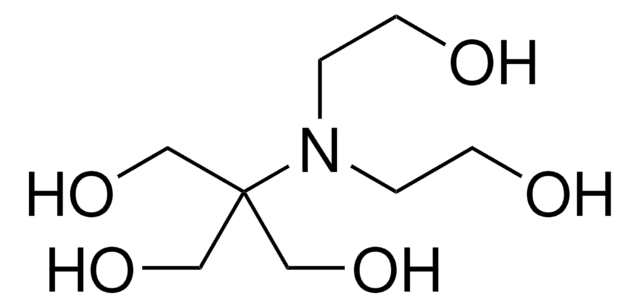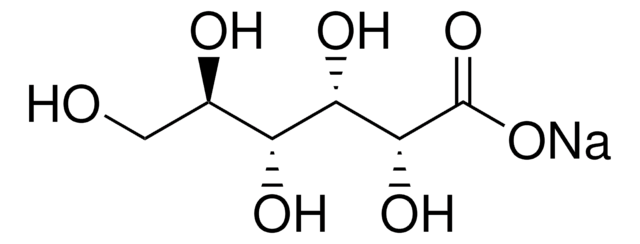T9784
Tricina
BioXtra, pH 4.0-6.0 (1 M in H2O), ≥99% (titration)
Sinonimo/i:
N-[tris(idrossimetil)metil]glicina
About This Item
Prodotti consigliati
Nome Commerciale
BioXtra
Livello qualitativo
Saggio
≥99% (titration)
Forma fisica
powder
Impurezze
≤0.005% Phosphorus (P)
≤0.1% Insoluble matter
Residuo alla calcinazione
≤0.1%
pH
4.0-6.0 (1 M in H2O)
Intervallo di pH utile
7.4-8.8
pKa (25 °C)
8.1
Solubilità
H2O: 1 M, clear, colorless
Anioni in tracce
chloride (Cl-): ≤0.1%
sulfate (SO42-): ≤0.05%
Cationi in tracce
Al: ≤0.0005%
Ca: ≤0.0005%
Cu: ≤0.0005%
Fe: ≤0.0005%
K: ≤0.005%
Mg: ≤0.0005%
NH4+: ≤0.05%
Na: ≤0.005%
Pb: ≤0.001%
Zn: ≤0.0005%
Assorbimento
≤0.05 at 280 in H2O at 1 M
≤0.1 at 260 in H2O at 1 M
applicazioni
diagnostic assay manufacturing
Stringa SMILE
OCC(CO)(CO)NCC(O)=O
InChI
1S/C6H13NO5/c8-2-6(3-9,4-10)7-1-5(11)12/h7-10H,1-4H2,(H,11,12)
SEQKRHFRPICQDD-UHFFFAOYSA-N
Cerchi prodotti simili? Visita Guida al confronto tra prodotti
Descrizione generale
Applicazioni
- in a polymerase chain reaction (PCR) buffer used in the single-cell collection
- as a component of lactotroph feeding medium for culturing lactotrophs
- to prepare luciferase assay reagent for luciferase activity assay in firefly Photonis pyralis and as a component in Triton/glycylglycine lysis buffer
Non trovi il prodotto giusto?
Prova il nostro Motore di ricerca dei prodotti.
Codice della classe di stoccaggio
13 - Non Combustible Solids
Classe di pericolosità dell'acqua (WGK)
WGK 3
Punto d’infiammabilità (°F)
Not applicable
Punto d’infiammabilità (°C)
Not applicable
Dispositivi di protezione individuale
Eyeshields, Gloves, type N95 (US)
Certificati d'analisi (COA)
Cerca il Certificati d'analisi (COA) digitando il numero di lotto/batch corrispondente. I numeri di lotto o di batch sono stampati sull'etichetta dei prodotti dopo la parola ‘Lotto’ o ‘Batch’.
Possiedi già questo prodotto?
I documenti relativi ai prodotti acquistati recentemente sono disponibili nell’Archivio dei documenti.
I clienti hanno visto anche
Il team dei nostri ricercatori vanta grande esperienza in tutte le aree della ricerca quali Life Science, scienza dei materiali, sintesi chimica, cromatografia, discipline analitiche, ecc..
Contatta l'Assistenza Tecnica.





